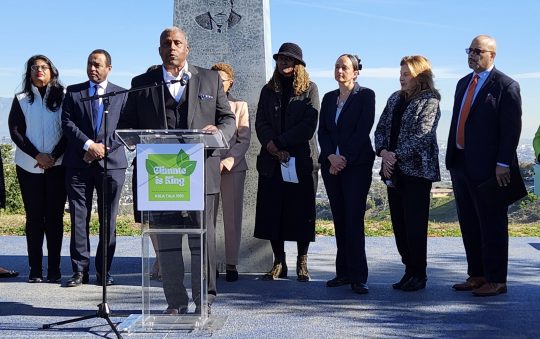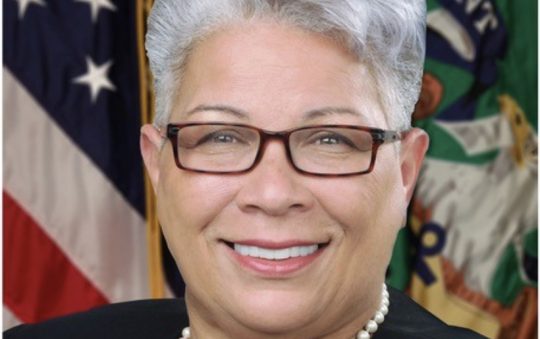
Draft Expenditure Plan Outlines more than $120 billion in Transit and Highway Projects to be Funded through a Potential Ballot Measure
Los Angeles County Metropolitan Transportation Authority (Metro) CEO Phillip A. Washington today unveiled staff recommendations for an expenditure plan as part of a possible November ballot measure that would fund a wide variety of transit and highway projects, roadway improvements and pedestrian and bike paths to be built over the next four decades.
“As LA Metro plans for future growth and transportation needs, it is imperative that we look at all mechanisms at our disposal to ensure the region’s mobility needs are met,” said Washington. “Working with our community stakeholders, this expenditure plan brings us a step closer in defining what projects are needed and where the funding could come from to complete those projects.”
The spending plan would also devote billions of dollars to pedestrian and cycling projects, commuter rail, transit operations and projects to keep buses, trains and facilities in good repair. The plan would return some revenues to local cities on a per capita basis — money those cities could spend on their own local transportation improvements.
The potential ballot measure would ask voters to increase the countywide sales tax by a half-cent for 40 years and to continue an existing tax (Measure R) for an extra 18 years, meaning both would potentially run through 2057. The staff report also provides the Board with scenarios for a 45- or 50-year scenario. The Metro Board of Directors has final say on the spending plan and is scheduled to decide in June whether to put a ballot measure to voters.
The foundation of the plan includes a host of transportation improvement projects submitted by stakeholders across the county. Metro staff has been hard at work over the last couple of months evaluating those projects against some key performance metrics for how well the projects will ease congestion and enhance mobility, provide better access, improve safety, grow the economy, and enhance quality of life.
The performance benefits of the plan include an increase of 80 million additional transit boardings per year or 3.2 billion additional riders during the 40 year period. Additionally, this will increase transit mode shares currently at 7% to a projected 20-30%. The major projects are estimated to reduce vehicle miles traveled by nearly 5 million daily (region wide), reduce person hours of delay on the road by 15 percent, and reduce daily hours of truck delay by 15%, resulting in greenhouse has reductions of four percent.
The full expenditure plan is available for public review at www.metro.net/theplan. The public is encouraged to take a look at the plan, realizing that it is a working draft document and is subject to change as the process goes forward. The Board of Directors will decide at their March 24 meeting whether to formally release the plan for public review and input. The public will be able to provide input through a variety of ways including public meetings, telephone town hall meetings or at [email protected].
Metro estimates the new ballot measure would raise more than $120 billion. By comparison, the Measure R half-cent sales tax approved by county voters in 2008 is projected to raise $35 billion to $40 billion over its 30-year lifespan.
With the recent opening of the Metro Gold Line Extension to Azusa and the opening of the Expo Line extension to Santa Monica in May, Measure R has already funded the completion of two rail projects, three others that are under construction, and numerous other highway and local improvements.
Metro’s Board of Directors will then have the final say on what’s included in the plan and whether to put the plan before Los Angeles County voters in November. That decision will follow an aggressive outreach and public review period from March through May with a host of community meetings and telephone town hall meetings. Following those meetings, public input will be compiled and shared with Board members as they contemplate a final expenditure plan and decide at their June meeting whether to put the measure on the November ballot.
Under the expenditure plan, here is a list of projects slated for completion in its first 15 years:
- Crenshaw/LAX Line station and transit center to connect with LAX people mover
- Purple Line Extension subway to Westwood (a decade earlier than currently planned)
- East San Fernando Valley Transit Corridor from Orange Line Van Nuys Station to Sylmar/San Fernando Metrolink Station
- High Desert Corridor right-of-way acquisition
- Sepulveda Pass Busway/ExpressLanes from the Valley to the Westside
- Orange Line grade seperation improvements
- West Santa Ana Branch Corridor from Artesia to just north of the Green Line
- I-710 South Corridor truck lanes Phase 1
- Vermont Transit Corridor improvements between the Expo Line and the Red/Purple Line
- New lanes for the 71 freeway between the 10 and Rio Rancho Road
- 105 ExpressLanes between the 405 and 605
- I-5 North enhancements between the 14 freeway and Lake Hughes Road
- An extension of the Gold Line east from Azusa to Claremont
- Bus rapid transit connector between the Orange Line/Red Line and the Gold Line
- LA River Bike Path connecting downtown Los Angeles to the San Fernando Valley
- LA River Waterway & System Bike Path connecting Canoga Park to Elysian Valley
- Crenshaw/LAX Track Enhancement Project
Numerous other projects will be completed as well. The full listing can be found in attachments to the expenditure plan board report, which is available on the Metro website at www.metro.net/theplan.






